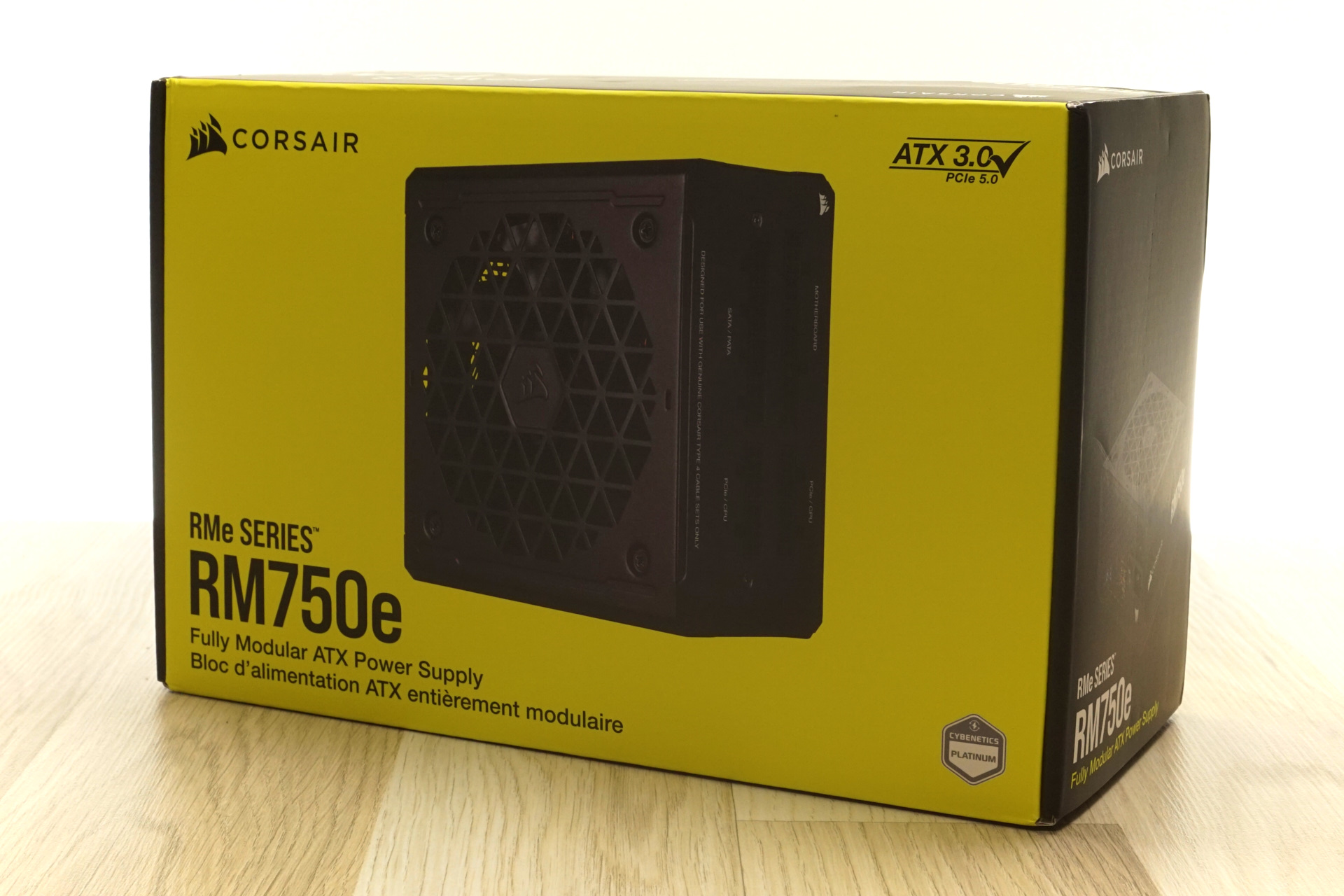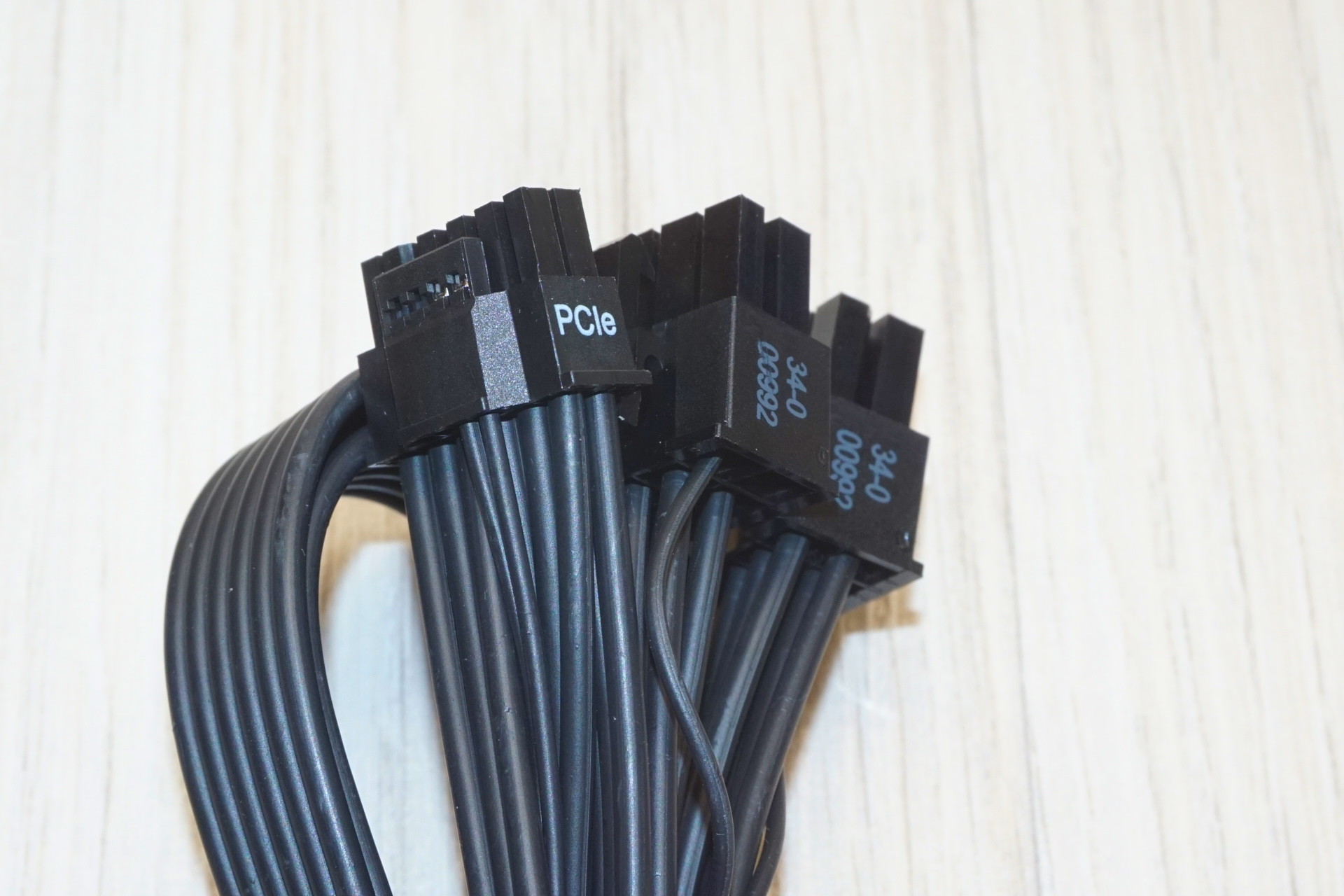Tom's Hardware Verdict
The Corsair RM750e is a feature-rich power supply aimed at mainstream users, offering solid performance and ATX 3.1 compliance. However, its thermal efficiency drops noticeably under load, and component quality, while decent, is not top-tier. Despite its limitations, it provides a good balance between performance and cost for mid-range builds.
Pros
- +
ATX 3.1 compliant
- +
Strong ripple suppression
- +
80Plus Gold certified
- +
Modular cable design
- +
Quiet under low loads
Cons
- -
Efficiency drops under heat
- -
Mid-tier internal components
- -
Limited number of connectors
- -
Fan noise at high load
- -
Risk of overload with 12V-2x6
Why you can trust Tom's Hardware
As mainstream power supplies continue to make their subtle shift to the ATX 3.1 standard, the pace of change is picking up. Already most vendors offer at least one ATX 3.1 unit in their lineups, and thanks to the relatively small set of changes that come with the revised standard, PSU vendors have largely been able to tweak their existing ATX 3.0 designs, allowing for them to quickly roll-out updated power supplies. This means that the inflection point for ATX 3.1 as a whole is quickly approaching, as more and more designs get their update and make their way out to retail shelves.
Today we're looking at our first ATX 3.1-compliant PSU from Corsair, one of the industry's most prolific (and highest profile) power supply vendors. The company’s revised RMe line of power supplies are aimed at the mainstream gaming market, which is perhaps not too surprising given how important ATX 3.1 support and safety are to video cards. The RM750e model we're looking at today is the smallest capacity for the lineup, which stretches from 750 Watts up to a hefty 1200 Watts.
Overall, the RM750e is built to compete with the best power supplies, and boasts a great balance between features, performance, and cost. It is an 80Plus Gold certified unit with modular cables and PCIe 5.1/ATX 3.1 certified, offering a single 600W 12V-2x6 connector. We will explore its specifications, construction, and performance to determine its standing in today’s market.
Specifications and Design
| RAIL | +3.3V | +5V | +12V | +5Vsb | -12V |
| MAX OUTPUT | 20A | 20A | 62.5A | 3A | 0A |
| Row 2 - Cell 0 | 110W | 110W | 750W | 15W | 0W |
| TOTAL | 750W | 750W | 750W | 750W | 750W |
| AC INPUT | 100 - 240 VAC, 50 - 60 Hz | 100 - 240 VAC, 50 - 60 Hz | 100 - 240 VAC, 50 - 60 Hz | 100 - 240 VAC, 50 - 60 Hz | 100 - 240 VAC, 50 - 60 Hz |
| MSRP | $99 | Row 5 - Cell 2 | Row 5 - Cell 3 | Row 5 - Cell 4 | Row 5 - Cell 5 |
In the Box
The Corsair RM750e 750W PSU is packaged in a typical cardboard box featuring Corsair's yellow and black color theme, with an image of the PSU on the front. Though it is labeled as ATX 3.0, Corsair has confirmed that the unit is ATX 3.1 compliant, and the packaging has not been updated yet. Inside, the PSU is protected by a nylon bag and dense packaging foam, ensuring it arrives safely.


The bundle includes mounting screws, an AC power cable, and a few basic cable ties, covering the essentials for installation.
This PSU features an all-black cable design, with the ATX 24-pin connector sleeved and the remaining cables in a flat, ribbon-like style. The 600W 12V-2x6 connector is perhaps the highlight here, as it connects to two 8-pin PCIe connectors to the PSU side.
In a roundabout manner, Corsair's use of a non-standard method of connecting a 12V-2x6 cable to the PSU itself has been a critical factor in being able to ship an ATX 3.1-compliant model so soon. Since the company isn't using the 12V-2x6 (or 12VHPWR) connector on the PSU itself, the PSU didn't need to be physically retooled. Even the "original" 12VHPWR-era cable is fine for ATX 3.1 compliance, since the spec didn't change the male connector.
Get Tom's Hardware's best news and in-depth reviews, straight to your inbox.
| Connector type | Hardwired | Modular |
|---|---|---|
| ATX 24 Pin | - | 1 |
| EPS 4+4 Pin | - | 2 |
| EPS 8 Pin | - | - |
| PCI-E 5.0 | - | 1 |
| PCI-E 8 Pin | - | 3 |
| SATA | - | 7 |
| Molex | - | 4 |
| Floppy | - | - |
External Appearance
The Corsair RM750e 750W PSU adheres to the ATX design guide with a chassis length of 140 mm, ensuring compatibility with any standard ATX-compliant tower PC case. The only direct downside here is the usual one, which is that the body length limits the cooling fan size to 120 mm.


The PSU features a smooth satin black finish with geometric design elements such as chamfered edges, and includes large decorative stickers that cover most of the left and right sides. The top side of the unit hosts a sticker with the electrical specifications and certifications. At the bottom side of the PSU, we find the fan finger guard integrated into the chassis itself, featuring a geometric triangular cutout pattern.
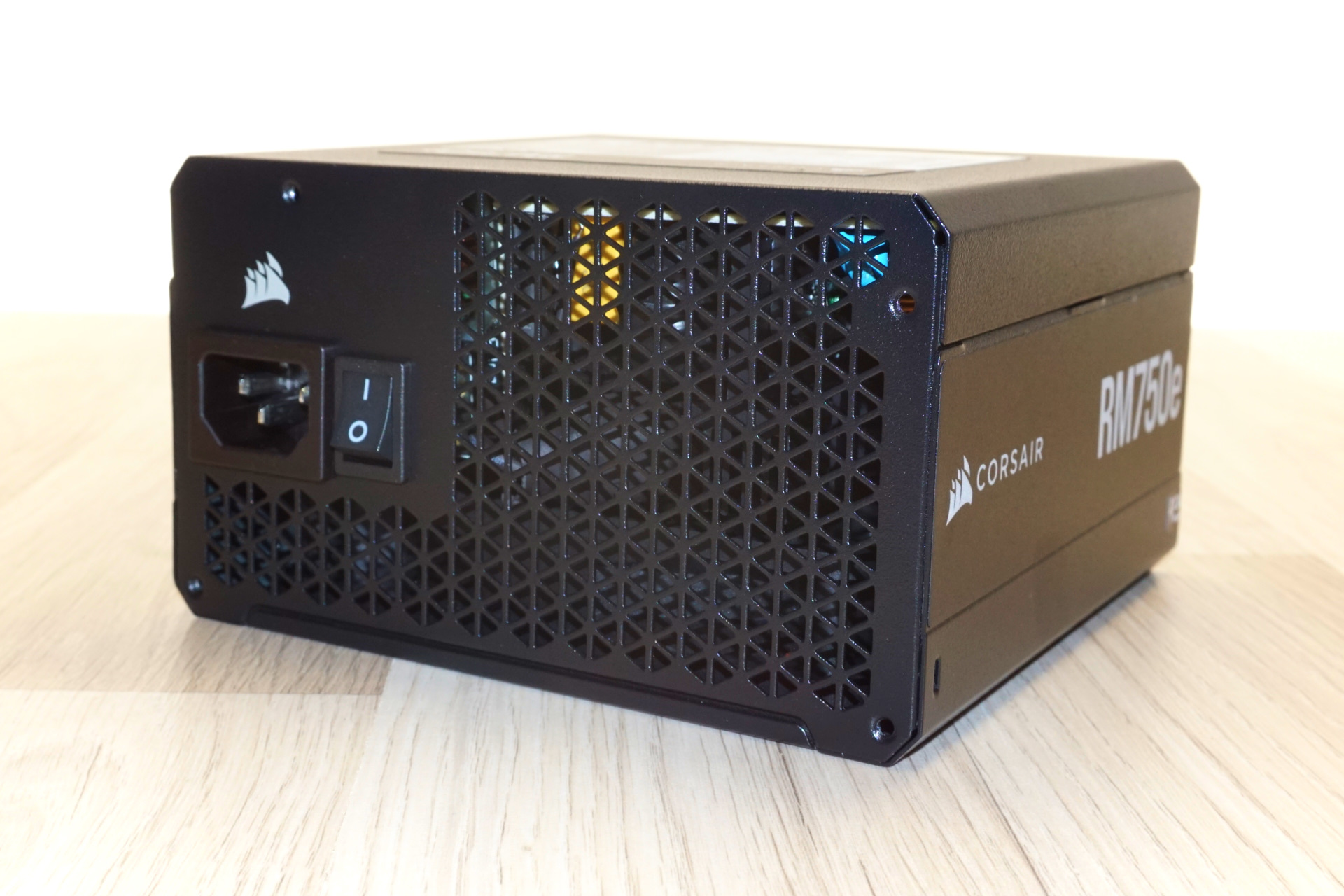
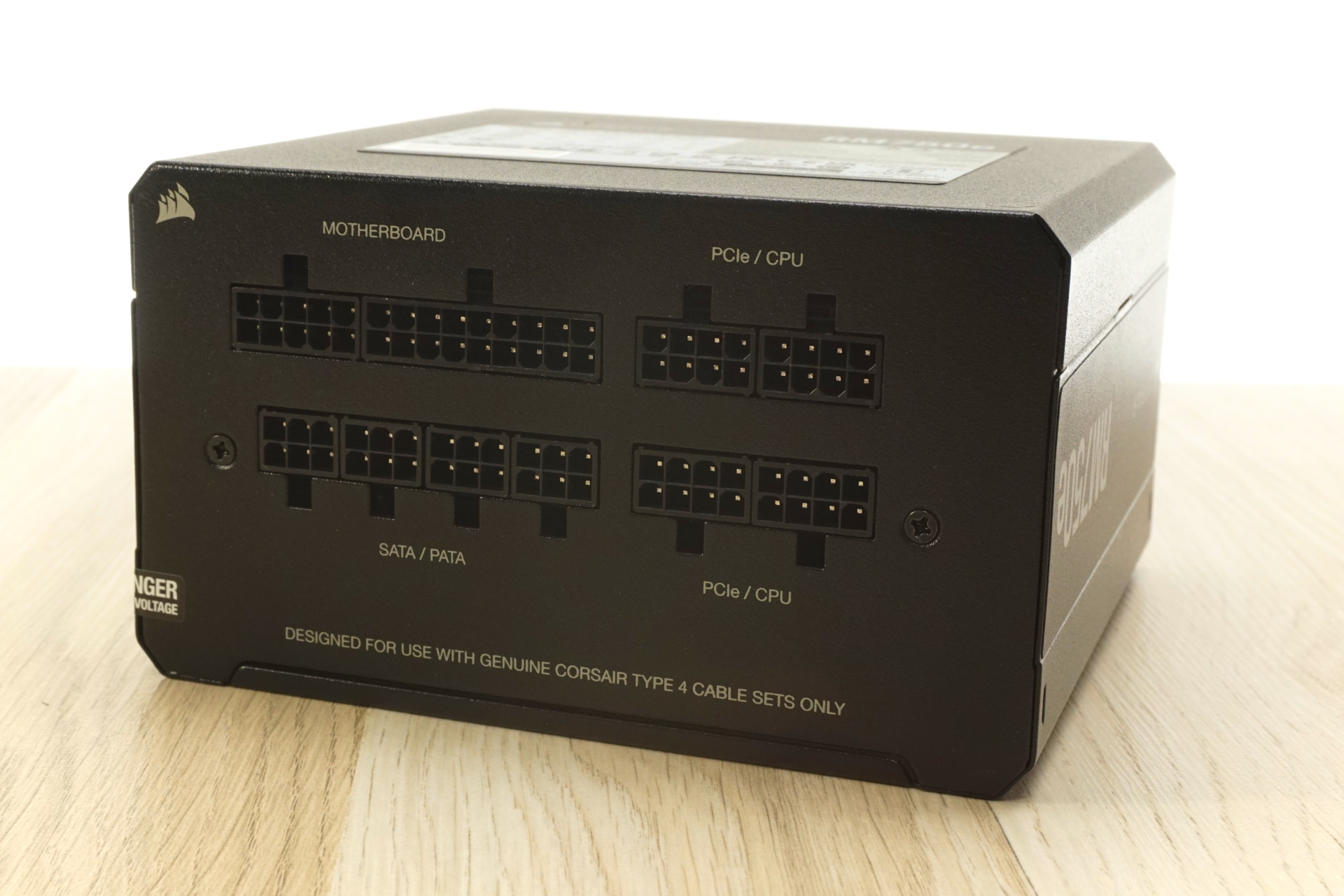
On the front side, the PSU features just the standard on/off switch and AC cable receptacle. The rear side houses the modular cable connectors, which are labeled with a basic white legend. The number of connectors limits the number of cables that can be attached at the same time, as there are only four PCIe/CPU connectors and seven cables to choose from (two CPU 12V, three PCI Express 8-pin, and the 12V-2x6 cable requires two connectors). A small white imprint of the company logo is located at the top left corner.
Internal Design
The Corsair RM750e 750W PSU is equipped with a Hong Hua 1225H12F-Z 120 mm fan, utilizing a rifle-bearing (sleeve) engine. This type of fan is known for its good balance of reliability, noise levels, and cost. It has a high maximum speed of 2200 RPM, which should be more than adequate for a 750W unit.
The OEM for the RM750e is HEC/Compucase, a well-established company with extensive experience in the power electronics industry since 1979. Although traditionally focused on cost-effective solutions, HEC/Compucase has recently developed platforms for mid-range and high-performance PC PSUs.
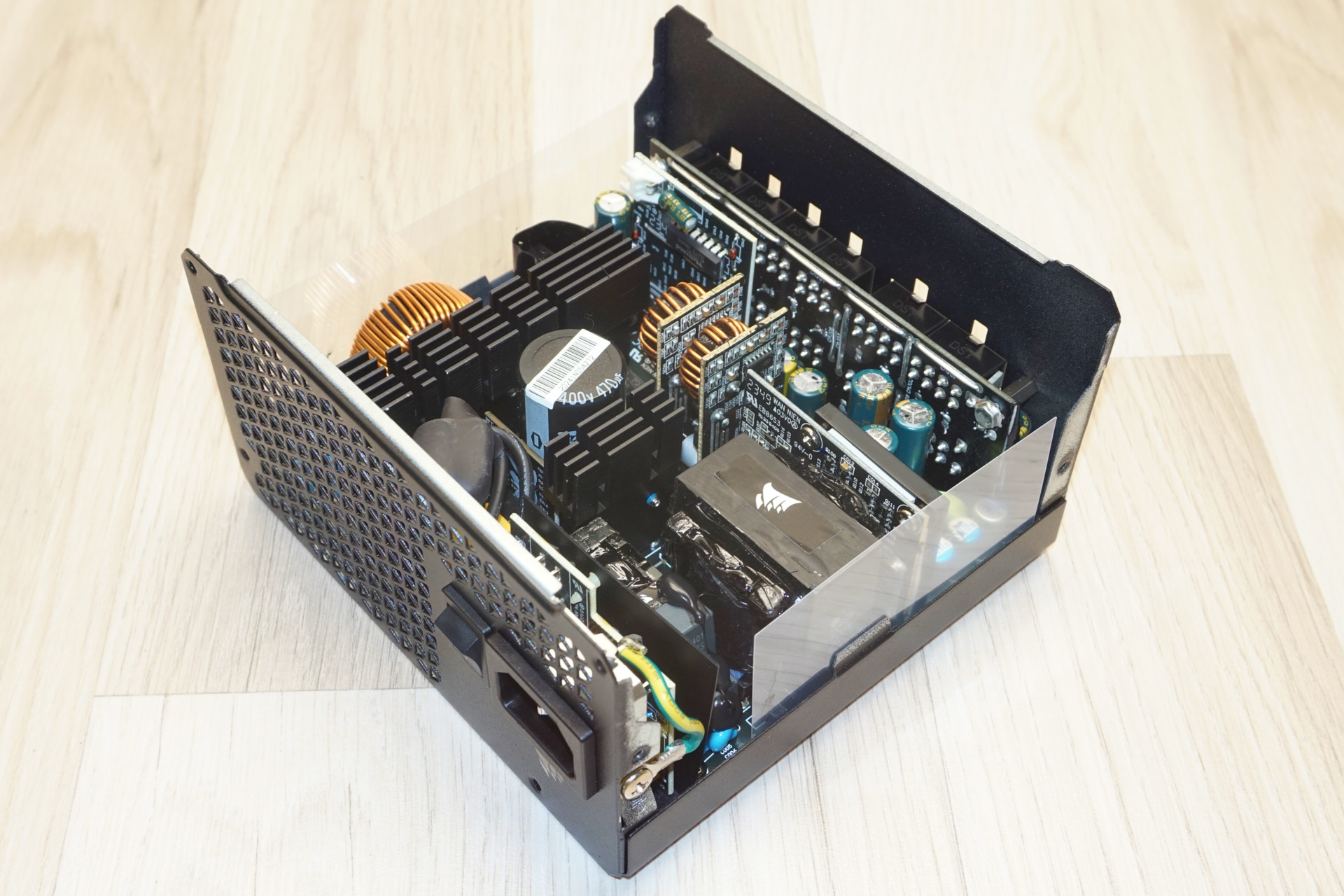

The RM750e's electrical design features established topologies aimed at ensuring reliability. The input stage includes a robust filtering setup with four Y capacitors, three X capacitors, and two filtering inductors. The two rectifying bridges are sharing the main heatsink with the APFC components, which are two Infineon 60R120P7 APFC MOSFETs and a diode. A typical inductor paired with a Teapo 470 μF capacitor are the passive components of the APFC circuitry.



In the primary inversion stage, the PSU employs a typical half-bridge LLC topology using two Infineon 60R120P7 MOSFETs mounted on a dedicated heatsink. The secondary stage features a synchronous rectification circuit on a vertical daughterboard for the primary 12V line, with additional DC-to-DC circuits on small vertical daughterboards generating the 3.3V and 5V lines. The secondary side MOSFETs are hidden beneath a metallic slab that serves as a basic heatsink. Secondary side capacitors are primarily supplied by Teapo, with a few Nippon Chemi-Con capacitors included.
Cold Test Results
Cold Test Results (25°C Ambient)
For the testing of PSUs, we are using high precision electronic loads with a maximum power draw of 2700 Watts, a Rigol DS5042M 40 MHz oscilloscope, an Extech 380803 power analyzer, two high precision UNI-T UT-325 digital thermometers, an Extech HD600 SPL meter, a self-designed hotbox and various other bits and parts.





The Corsair RM750e 750W PSU comfortably meets the 80Plus Gold certification requirements, despite the notable impact of input voltage on efficiency. When tested with a 115 VAC input, this PSU achieves an average nominal load efficiency of 89.5% across its operational range from 20% to 100% capacity, which increases to 92.4% with a 230 VAC input. The efficiency drop of 2.9% due to the input voltage is perhaps the highest that we have seen to this date, but that has no other effect on the unit’s performance or quality. The efficiency peaks at a load near the midpoint of its capacity. The efficiency under very low load conditions is mediocre.
The Corsair RM750e 750W PSU features a hybrid fan mode, allowing the fan to remain off under low-load conditions to maintain silence. The fan begins operating only when thermally necessary, which in our tests occurred at loads exceeding approximately 150 Watts, a fairly low load point. At typical room temperatures, this means the PSU operates quietly while the system is idling but is unlikely that the fan will stay off with as much as a hint of system load. However, even though the fan starts, it maintains very low RPM up to roughly 500 Watts, with the RM750e being practically inaudible up to that point.
Overall, we really only see the fan on the RM750e really ramp up when the PSU approaches its maximum load – roughly the last 100 Watts from 650W to 750W. Though even then, there's more than enough cooling capacity to allow the fan to remain below its maximum speed.
Hot Test Results
Hot Test Results (~45°C Ambient)
Inside our hotbox, the Corsair RM750e 750W PSU exhibits a significant decrease in efficiency under heavy loads, with figures of 87.3% under a 115 VAC input and 90.1% with a 230 VAC source, compared to 89.5% and 92.4%, respectively, during cold testing. This reduction in efficiency is both higher than anticipated and inconsistent across the load range, with the efficiency gap widening as the load increases, suggesting measurable thermal stress, even though the internal temperatures of the unit are relatively low.




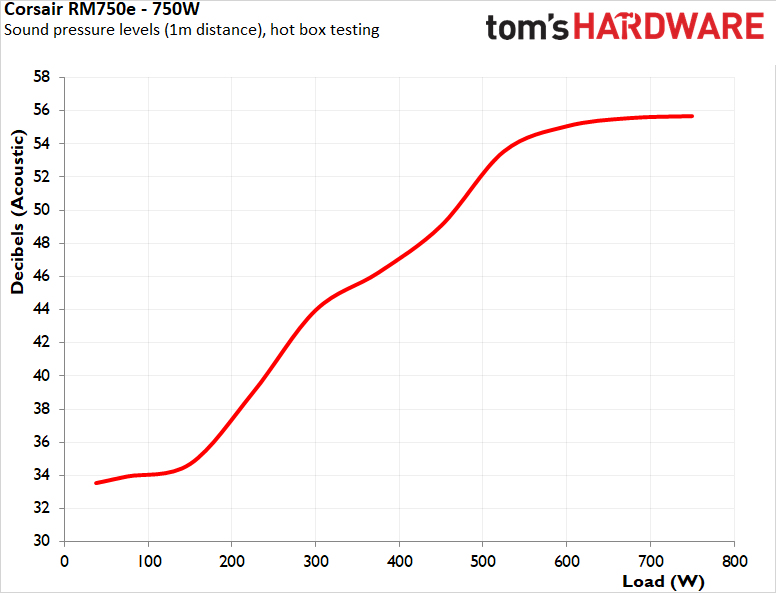
Under hot testing conditions, the Corsair RM750e PSU's fan activates almost immediately and ramps up its speed more aggressively compared to cooler environments, almost linearly with respect to the load. As the load approaches 80% capacity, the fan reaches its maximum speed. The acoustic levels are manageable up to 30% load but the unit will become clearly audible after that.
The thermal performance of the Corsair RM750e is good, with the unit maintaining fairly low internal temperatures despite the efficiency drop. Although the fan’s speed peaks at just 80% load, the internal temperatures of the unit are relatively low despite the very high ambient temperature, even at 100% load. This bodes well for the long-term reliability of the unit, especially if we were to consider its passive components a notch below what we usually find in top-tier units quality-wise.
PSU Quality and Bottom Line
Power Supply Quality
The electrical performance of the Corsair RM750e 750W PSU is commendable for its class, demonstrating fairly good voltage regulation across all outputs. The 12V rail maintains a regulation of 1.1%, while the 5V and 3.3V lines perform well at 1.3% and 1.2%, respectively. Ripple suppression is also exceptional for a PSU of this class, with the 12V, 5V, and 3.3V lines registering low values at 38 mV, 28 mV, and 26 mV, respectively. These are excellent figures, especially considering the signs of stress under maximum load.
| Load (Watts) | 151.34 | Row 0 - Cell 2 | 376.98 W | Row 0 - Cell 4 | 563.12 W | Row 0 - Cell 6 | 748.61 W | Row 0 - Cell 8 |
| Load (Percent) | 20.18% | Row 1 - Cell 2 | 50.26% | Row 1 - Cell 4 | 75.08% | Row 1 - Cell 6 | 99.81% | Row 1 - Cell 8 |
| Row 2 - Cell 0 | Amperes | Volts | Amperes | Volts | Amperes | Volts | Amperes | Volts |
| 3.3 V | 1.8 | 3.38 | 4.5 | 3.38 | 6.75 | 3.34 | 9 | 3.34 |
| 5 V | 1.8 | 5.07 | 4.5 | 5.04 | 6.75 | 5 | 9 | 5 |
| 12 V | 11.25 | 12.1 | 28.14 | 12.05 | 42.2 | 12.01 | 56.27 | 11.97 |
| Line | Regulation (20% to 100% load) | Voltage Ripple (mV) | Header Cell - Column 3 | Header Cell - Column 4 | Header Cell - Column 5 | Header Cell - Column 6 | Header Cell - Column 7 |
|---|---|---|---|---|---|---|---|
| Row 0 - Cell 0 | Row 0 - Cell 1 | 20% Load | 50% Load | 75% Load | 100% Load | CL1 12V | CL2 3.3V + 5V |
| 3.3V | 1% | 12 | 18 | 22 | 26 | 16 | 22 |
| 5V | 1.3% | 16 | 20 | 24 | 28 | 16 | 24 |
| 12V | 1.1% | 16 | 24 | 30 | 38 | 38 | 24 |
During our thorough assessment, we evaluate the essential protection features of every power supply unit we review, including Over Current Protection (OCP), Over Voltage Protection (OVP), Over Power Protection (OPP), and Short Circuit Protection (SCP). The Corsair RM750e 750W PSU successfully passed all crucial protection tests. The unit displayed standard Over Current Protection (OCP) settings for the 3.3V and 5V rails, activating at 120%, which is typical for these specifications. The 12V rail’s OCP activation at 134% is significantly higher, aligning with the latest industry practices where manufacturers have adjusted protections to meet the newest power excursion guidelines.
Bottom Line
The Corsair RM750e 750W PSU presents itself as a well-rounded and robust power supply unit, especially when considering its retail price of $95. Aesthetically, the RM750e features a futuristic design with chamfered and all-black ribbon cables. The geometric triangular pattern of the fan finger guard also helps the RM750e to visually stand out of the crowd. And thanks to the inclusion of a modern 12V-2x6 power cable, it can even be used to drive significantly powerful gaming PCs. Though, because that cable can eat 80% of the unit’s capacity all by itself, Corsair has pragmatically limited the total number of cables that can be simultaneously connected to the unit.
The packaging, while still labeled as ATX 3.0, houses a unit that supposedly meets ATX 3.1 compliance. Because Corsair didn't need to make any changes to the physical pin-out of its PSU to reach ATX 3.1 compliance, Corsair has similarly made minimal, if any, internal adjustments under the hood. At most, the company likely just needed to tweak the Over Current Protection (OCP) and Over Power Protection (OPP) triggers to align with the newer design guide criteria.
Performance-wise, the RM750e shows competent efficiency, meeting 80Plus Gold certification standards during cold testing with 89.5% efficiency at 115 VAC and 92.4% at 230 VAC. Even under hot testing conditions, where efficiency drops to 87.3% at 115 VAC and 90.1% at 230 VAC, the PSU continues to perform reliably. This decline however is higher than expected, especially when the load is high, and highlights a vulnerability to higher temperatures that could impact long-term reliability in warmer environments. The fan, while generally quiet at low loads and when the ambient temperature is normal, can become significantly louder as the load increases if the unit is placed inside a very warm operating environment.
Similarly, the electrical performance of the RM750e is notable, showcasing strong voltage regulation and excellent ripple suppression across all outputs. With 12V rail regulation at 1.1%, and 5V and 3.3V lines at 1.3% and 1.2% respectively, the unit does not stand out in a crowded market, but these figures still are superb for a mainstream PC PSU. The low voltage ripple values under stress further underscore its power output quality, making it a dependable choice for both gaming and mainstream use.
The Corsair RM750e 750W PSU is a competent power supply with several strengths, but is also not without weaknesses. Including a 600W-capable 12V-2x6 cable on a 750W PSU calls for a careful balancing act that can require user intervention – the PSU will happily physically let you plug in a top-tier GPU with a power-hungry CPU, even if the combined load is too much for the PSU to handle. It's admittedly more of a theoretical edge case right now (virtually no video cards require the full 600W), but it does underscore the need for careful planning on the user's part.
Quality-wise, this RM750e cannot boast having components from top-tier manufacturers, and the platform itself is from an OEM whose products are infrequent in the advanced PC market. But, regardless, its quality is undoubtedly above average, and the 7-year warranty is fairly reassuring. Otherwise it offers robust all-around performance and will endure severe operating conditions, though the PSU is certainly better suited for normal room-temperature conditions. Consequently, with its $99 price tag, the RM750e is a solid investment for those PC builders seeking a cost-effective power supply with good all-around performance.
MORE: Best Power Supplies
MORE: How We Test Power Supplies
MORE: All Power Supply Content

Dr. E. Fylladitakis has been passionate about PCs since the 8088 era, beginning his PC gaming journey with classics like Metal Mutant and Battle Chess. Not long after, he built his first PC, a 486, and has been an enthusiast ever since. In the early 2000’s, he delved deeply into overclocking Duron and Pentium 4 processors, liquid cooling, and phase-change cooling technologies. While he has an extensive and broad engineering education, Dr. Fylladitakis specializes in electrical and energy engineering, with numerous articles published in scientific journals, some contributing to novel cooling technologies and power electronics. He has been a hardware reviewer at AnandTech for nearly a decade. Outside of his professional pursuits, he enjoys immersing himself in a good philosophy book and unwinding through PC games.
-
Mindstab Thrull Did anyone else notice that the table marked for what cables are included - hardwired and modular - is labeled as a COUGAR unit?Reply

